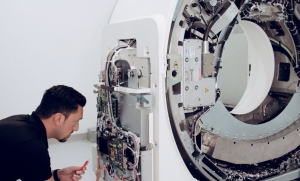by
John R. Fischer, Senior Reporter | December 18, 2023
In the MR suite, providers have to walk a line between keeping scanners well maintained and up to date, and avoiding costly unplanned downtime. In recent years, remote monitoring capabilities have been a game changer.
These technologies generate alerts in real time to minor irregularities in components and environments that risk snowballing into bigger problems if left unaddressed. Responding promptly to changes in chiller water temperature or coldhead function, for example, can prevent weeks of unplanned downtime, hefty repair costs, and loss of revenue from canceled appointments.
Scanner manufacturers have been finding ways to bake AI into their equipment software in recent years, and remote monitoring represents a huge opportunity for that. It fits neatly into efforts to eliminate traditional break-and-fix service models in favor of predictive and preventive approaches to maintenance, which are expected to evolve as AI algorithms improve.



Ad Statistics
Times Displayed: 46608
Times Visited: 1410 MIT labs, experts in Multi-Vendor component level repair of: MRI Coils, RF amplifiers, Gradient Amplifiers Contrast Media Injectors. System repairs, sub-assembly repairs, component level repairs, refurbish/calibrate. info@mitlabsusa.com/+1 (305) 470-8013
Despite that tremendous potential, AI-based remote monitoring alone cannot fully service an MR scanner. It’s just one piece of the puzzle. HCB News sat down with three MR manufacturers to talk about how they’re adapting their service offerings to incorporate the latest capabilities and customizing agreements based on the unique needs of a given provider.
Reducing maintenance and repair time
Healthcare providers today seek more risk-sharing service models that reduce overhead by allowing them to pick and choose which services are provided by the manufacturer or independent service team, versus which can be overseen in-house by biomedical personnel.
To accommodate these demands, many MR vendors offer training and support resourced to in-house service teams. United Imaging Healthcare, for example, has a cloud-based Empower Platform to connect biomedical engineers to its national service infrastructure, from which they can order parts, and view call center cases, work orders, service appointments, and more.
AI helps make risk-sharing service models like these more feasible for providers, according to Troy Lewein, U.S. vice president of MRI at United Imaging Healthcare. It also speeds up jobs by automating tedious and complex tasks and processes involved in repairs and maintenance.
“The system can self-diagnose and self-treat software issues before a field service engineer gets on site,” Lewein told HCB News. “For hardware repairs, the system can develop its own action plan and send for the appropriate part, so that the field service engineer or in-house biomedical engineer has everything he or she needs to significantly reduce system downtime once they get on site.”

